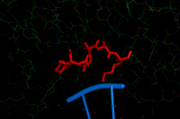Sandbox 666
From Proteopedia
Hello this Sandbox is reserved for a student project. It describes the structure of the endonuclese restriction enzyme Eco RI.
| |||||||
| 1eri, resolution 2.50Å () | |||||||
|---|---|---|---|---|---|---|---|
| |||||||
| Resources: | FirstGlance, OCA, PDBsum, RCSB | ||||||
| Coordinates: | save as pdb, mmCIF, xml | ||||||
Contents |
Presentation
EcoRI is a type II restriction endonuclease. It recognizes and cleaves DNA on a specific palindromic sequence: GAATTC. EcoRI has been extracted from strain R Escherichia coli, a common bacterium which populates the intestine of mammalians. In bacteria, restriction enzymes protect the cell by cutting foreign DNA from bacteriophages (specific bacterial viruses).
Reaction
EcoRI (E.C. 3.1.21.4) is a hydrolase and its substrate is a double-strand DNA molecule and two water molecules. For its catalytic activity, EcoRI needs a cofactor which is the divalent ion Mg2+. EcoRI hydrolyses the phosphodiester bond between the guanylic and adenylic residues resulting in 5’-phosphate sticky ends which are complementary.
Structure
EcoRI is a homodimer, so it has two identical subunits (Representation of one ) of 31 kDa, but it possible to have homotetramers at high concentrations. The constitutive monomers are 276 amino acids long. EcoRI and all the other restriction enzymes show a common structural core which is a α/β domain. The constitutive subunits of EcoRI are organized into a single α/β domain (five stranded sheet which is surrounded by ). Four of these five β strands are parallel whereas the fourth (β4) is in an anti-parallel orientation to the others.[1]
In the old model the N-terminal section of each subunit forms the inner arm which wraps around the DNA molecule (The arm brings the DNA molecule to the catalytic cleft.).The new chain tracing, based on new elements of electron density and anew interpretation that alters the assignment of specific amino acid residues to some of the original features[2]. In the new model,the Inner arm is the extended chain motif (Met137to Ala142)is a segment of extended polypeptide chain that runs through the major groove of the DNA, roughly parallel to the DNA backbone[3]. The Outer arm is composed of two minor β strands linked together by a loop (the outer arm is 14 amino acids long, four of these amino acids belong to the loop).
The specific recognition of EcoRI of the GAATTC sequence is mediated by twelve hydrogen bonds (six bonds per subunit) originating from α helical recognition modules. Three amino acids are responsible for the recognition:Arg200, Glu144 and Arg145. These aminoacids are shown in red .Each residue form two hydrogen bonds with Guanine and the adjacent Adenosine residues respectively.
Application of EcoRI in molecular biology
Type II restriction endonuclease like EcoRI are often used in molecular biology for their capacity to cut precisely DNA on specific restriction site. That makes them useful tools for gene cloning. By using two different restriction enzymes, it is possible to do directional cloning which is very important if you want to insert a gene in an expression vector.
Links
[1] 1ERI in the Protein Database (PDB)
References
- ↑ Refinement of Eco RI endonuclease crystal structure: a revised protein chain tracing. Kim YC, Grable JC, Love R, Greene PJ, Rosenberg JM.
- ↑ Refinement of Eco RI endonuclease crystal structure: a revised protein chain tracing. Kim YC, Grable JC, Love R, Greene PJ, Rosenberg JM.
- ↑ Refinement of Eco RI endonuclease crystal structure: a revised protein chain tracing. Kim YC, Grable JC, Love R, Greene PJ, Rosenberg JM.
- ↑ Structure and function of type II restriction endonucleases Alfred Pingoud, Albert Jeltsch Nucleic Acids Res. 2001 September 15; 29(18): 3705–3727. PMCID: PMC55916

